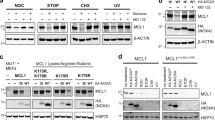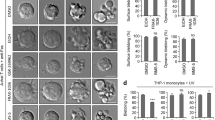Abstract
Apollon (also known as BRUCE or BIRC6) is a large protein containing baculoviral-IAP-repeat (BIR) and ubiquitin-conjugating enzyme (UBC) domains at the amino- and carboxy termini, respectively. Apollon inhibits apoptosis, but its molecular and physiological function remains unclear. Here we report that Apollon binds to, ubiquitinates and facilitates proteasomal degradation of SMAC and caspase-9, which both contain IAP-binding motifs. Targeted disruption of Apollon in mice caused embryonic and neonatal lethality. Notably, SMAC induced apoptosis in Apollon-deficient cells, but not in Apollon-expressing cells. Furthermore, the IAP-binding motif of SMAC was required to induce apoptosis in Apollon-deficient cells. These results suggest that Apollon has an essential function in preventing SMAC-induced apoptosis.
This is a preview of subscription content, access via your institution
Access options
Subscribe to this journal
Receive 12 print issues and online access
$209.00 per year
only $17.42 per issue
Buy this article
- Purchase on Springer Link
- Instant access to full article PDF
Prices may be subject to local taxes which are calculated during checkout








Similar content being viewed by others
References
Nagata, S. Apoptosis by death factor. Cell 88, 355–365 (1997).
Hengartner, M.O. The biochemistry of apoptosis. Nature 407, 770–776 (2000).
Steller, H. Mechanisms and genes of cellular suicide. Science 267, 1445–1449 (1995).
Reed, J.C. Dysregulation of apoptosis in cancer. J. Clin. Oncol. 17, 2941–2953 (1999).
Yuan, J., Lipinski, M. & Degterev, A. Diversity in the mechanisms of neuronal cell death. Neuron 40, 401–413 (2003).
Nicholson, D.W. & Thornberry, N.A. Caspases: killer proteases. Trends Biochem. Sci. 22, 299–306 (1997).
Salvesen, G.S. & Dixit, V.M. Caspases: intracellular signaling by proteolysis. Cell 91, 443–446 (1997).
Reed, J.C. & Kroemer, G. Mechanisms of mitochondrial membrane permeabilization. Cell Death Differ. 7, 1145 (2000).
Kroemer, G. & Reed, J.C. Mitochondrial control of cell death. Nature Med. 6, 513–519 (2000).
Wang, X. The expanding role of mitochondria in apoptosis. Genes Dev. 15, 2922–2933 (2001).
Liu, X., Kim, C.N., Yang, J., Jemmerson, R. & Wang, X. Induction of apoptotic program in cell-free extracts: requirement for dATP and cytochrome c. Cell 86, 147–157 (1996).
Du, C., Fang, M., Li, Y., Li, L. & Wang, X. Smac, a mitochondrial protein that promotes cytochrome c-dependent caspase activation by eliminating IAP inhibition. Cell 102, 33–42 (2000).
Verhagen, A.M. et al. Identification of DIABLO, a mammalian protein that promotes apoptosis by binding to and antagonizing IAP proteins. Cell 102, 43–53 (2000).
Suzuki, Y. et al. A serine protease, HtrA2, is released from the mitochondria and interacts with XIAP, inducing cell death. Mol. Cell 8, 613–621 (2001).
Zou, H., Henzel, W.J., Liu, X., Lutschg, A. & Wang, X. Apaf-1, a human protein homologous to C. elegans CED-4, participates in cytochrome c-dependent activation of caspase-3. Cell 90, 405–413 (1997).
Li, P. et al. Cytochrome c and dATP-dependent formation of Apaf-1/caspase-9 complex initiates an apoptotic protease cascade. Cell 91, 479–489 (1997).
Reed, J.C. Double identity for proteins of the Bcl-2 family. Nature 387, 773–776 (1997).
Tsujimoto, Y. Cell death regulation by the Bcl-2 protein family in the mitochondria. J. Cell. Physiol. 195, 158–167 (2003).
Deveraux, Q.L. & Reed, J.C. IAP family proteins-suppressors of apoptosis. Genes Dev. 13, 239–52 (1999).
Hay, B.A. Understanding IAP function and regulation: a view from Drosophila. Cell Death Differ. 7, 1045–1056 (2000).
Salvesen, G.S. & Duckett, C.S. IAP proteins: blocking the road to death's door. Nature Rev. Mol. Cell Biol. 3, 401–410 (2002).
Deveraux, Q.L. et al. Cleavage of human inhibitor of apoptosis protein XIAP results in fragments with distinct specificities for caspases. EMBO J. 18, 5242–5251 (1999).
Roy, N., Deveraux, Q.L., Takahashi, R., Salvesen, G.S. & Reed, J.C. The c-IAP-1 and c-IAP-2 proteins are direct inhibitors of specific caspases. EMBO J. 16, 6914–6925 (1997).
Deveraux, Q.L., Takahashi, R., Salvesen, G.S. & Reed, J.C. X-linked IAP is a direct inhibitor of cell-death proteases. Nature 388, 300–304 (1997).
Sun, C. et al. NMR structure and mutagenesis of the inhibitor-of-apoptosis protein XIAP. Nature 401, 818–822 (1999).
Yang, Y., Fang, S., Jensen, J.P., Weissman, A.M. & Ashwell, J.D. Ubiquitin protein ligase activity of IAPs and their degradation in proteasomes in response to apoptotic stimuli. Science 288, 874–877 (2000).
Suzuki, Y., Nakabayashi, Y. & Takahashi, R. Ubiquitin-protein ligase activity of X-linked inhibitor of apoptosis protein promotes proteasomal degradation of caspase-3 and enhances its anti-apoptotic effect in Fas-induced cell death. Proc. Natl Acad. Sci. USA 98, 8662–8667 (2001).
Chen, Z. et al. A human IAP-family gene, apollon, expressed in human brain cancer cells. Biochem. Biophys. Res. Commun. 264, 847–854 (1999).
Hauser, H.P., Bardroff, M., Pyrowolakis, G. & Jentsch, S. A giant ubiquitin-conjugating enzyme related to IAP apoptosis inhibitors. J. Cell Biol. 141, 1415–1422 (1998).
Vernooy, S.Y. et al. Drosophila Bruce can potently suppress Rpr- and Grim-dependent but not Hid-dependent cell death. Curr. Biol. 12, 1164–1168 (2002).
Srinivasula, S.M. et al. A conserved XIAP-interaction motif in caspase-9 and Smac/DIABLO regulates caspase activity and apoptosis. Nature 410, 112–116 (2001).
Hunter, A.M. et al. A novel ubiquitin fusion system bypasses the mitochondria and generates biologically active Smac/DIABLO. J. Biol. Chem. 278, 7494–7499 (2003).
Yang, L. et al. Predominant suppression of apoptosome by inhibitor of apoptosis protein in non-small cell lung cancer H460 cells: therapeutic effect of a novel polyarginine-conjugated Smac peptide. Cancer Res. 63, 831–837 (2003).
Chai, J. et al. Structural and biochemical basis of apoptotic activation by Smac/DIABLO. Nature 406, 855–862 (2000).
Qiu, X.B., Markant, S.L., Yuan, J. & Goldberg, A.L. Nrdp1-mediated degradation of the gigantic IAP, BRUCE, is a novel pathway for triggering apoptosis. EMBO J. 23, 800–810 (2004).
Jesenberger, V. & Jentsch, S. Deadly encounter: ubiquitin meets apoptosis. Nature Rev. Mol. Cell Biol. 3, 112–121 (2002).
Arama, E., Agapite, J. & Steller, H. Caspase activity and a specific cytochrome c are required for sperm differentiation in Drosophila. Dev. Cell 4, 687–697 (2003).
Chai, J. et al. Molecular mechanism of Reaper–Grim–Hid-mediated suppression of DIAP1-dependent Dronc ubiquitination. Nature Struct. Biol. (2003).
Kanuka, H. et al. Control of the cell death pathway by Dapaf-1, a Drosophila Apaf-1/CED-4-related caspase activator. Mol. Cell 4, 757–769 (1999).
Okada, H. et al. Generation and characterization of Smac/DIABLO-deficient mice. Mol. Cell. Biol. 22, 3509–3517 (2002).
Sakai, K. & Miyazaki, J. A transgenic mouse line that retains Cre recombinase activity in mature oocytes irrespective of the cre transgene transmission. Biochem. Biophys. Res. Commun. 237, 318–324 (1997).
Dan, S. et al. Activation of c-Abl tyrosine kinase requires caspase activation and is not involved in JNK/SAPK activation during apoptosis of human monocytic leukemia U937 cells. Oncogene 18, 1277–1283 (1999).
Naito, M., Nagashima, K., Mashima, T. & Tsuruo, T. Phosphatidylserine externalization is a downstream event of interleukin-1 β-converting enzyme family protease activation during apoptosis. Blood 89, 2060–2066 (1997).
Acknowledgements
We thank R. Takahashi for critical reading of the manuscript, A. Tomida and N. Fujita for helpful discussion and H. Yamanaka and S. Ito for assistance in generation of the Bruce-knockout mice. This work was supported by Grants-in-Aid for Cancer Research from the Ministry of Education, Science, Sports and Culture, Japan.
Author information
Authors and Affiliations
Corresponding author
Ethics declarations
Competing interests
The authors declare no competing financial interests.
Rights and permissions
About this article
Cite this article
Hao, Y., Sekine, K., Kawabata, A. et al. Apollon ubiquitinates SMAC and caspase-9, and has an essential cytoprotection function. Nat Cell Biol 6, 849–860 (2004). https://doi.org/10.1038/ncb1159
Received:
Accepted:
Published:
Issue Date:
DOI: https://doi.org/10.1038/ncb1159



